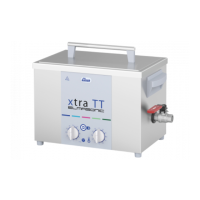Verification of operating functions
Elma Schmidbauer GmbH • Gottlieb-Daimler-Str. 17 • D-78224 Singen • Tel. +49 (0) 7731 / 882-0 • Fax +49 (0) 7731 / 882-266 • info@elma-ultrasonic.com •
www.elma-ultrasonic.com
Information on ultrasonic cleaning units
Elmasonic ultrasonic cleaning units are subject to the CE marking criteria. The manufacturer tests
the units through strict quality inspections before they are distributed. In these inspections the
electric functioning and the power consumption are tested in long-term trial runs. The quality
inspection results for each unit are recorded in individual test reports.
Please observe the instructions given in the operating manual, in particular the safety warnings
and the instructions on initial operation and on maintenance and service.
Basic information on the ultrasonic cleaning process
The electric high-frequency vibrations produced by the ultrasonic generator are transformed into
mechanic vibrations by one or several transducer elements which are mounted to the bottom of the
tank. In this process the highly energetic sound waves are transmitted into the cleaning liquid
(ordinarily water + tensides added to reduce the surface tension) in alternating phases of high and
low pressure. During the low-pressure phase of a sound wave millions of minuscule vacuum
bubbles are created which collapse in the high-pressure phase. These implosions produce jets
moving through the liquid at a speed of up to 3,000 m/sec and releasing a very high energy. This
effect is called cavitation. The cavitation process works best on surfaces of immersed items and
dissolved substances. Particles are “blown off” and dissolved in the cleaning liquid. This secondary
effect of the cavitation process and the implosion is audible as a hissing sound.
The transducer elements are designed so that the ultrasonic energy reaches the immersed items
as evenly as possible. The sweep mode which can be switched on during operation guarantees a
uniform sound field distribution and prevents the forming of dead zones in the cleaning liquid.
General information on the heating of the cleaning liquid due to ultrasound
Cleaning liquids heat up during ultrasonic operation, in particular when the unit is operated over
prolonged periods of time. The temperature inside the cleaning bath can easily reach 60 °C or
more depending on the operation period.
Check the temperature regularly / at least before each new cleaning cycle, by means of a digital
thermometer (with the ultrasound switched off).
Evaporation and exposition
Prevent the evaporation of the cleaning liquid by operating the unit with a suitable cover.
Routine inspections
The operating functions of the Elmasonic units must be checked according to the relevant
instructions, at least on each work day before putting into operation; the unit must be monitored
during operation. For this please apply the methods listed in this information brochure (see section
Inspection of the functioning of the unit – Detection of malfunctions).
Putting into operation
Fill the ultrasonic tank up to the proper filling level (approx. 2/3 or level marking on the tank wall)
with water and add a wetting agent, e.g. cleaning chemical. Please note: The distribution of power
is influenced by the reflection of the ultrasonic waves at the surface of the water, i.e. a filling level
that differs considerably from the recommended level can reduce the ultrasonic performance.
When a new cleaning bath is filled, oxygen from the air is taken into the bath. The oxygen in the
bath absorbs the ultrasonic power and effects the first cleaning cycle negatively. Therefore operate
the ultrasonic unit for several minutes to degas the bath before you put any cleaning items
inside and start the cleaning process. Ultrasonic units of the Elmasonic S series are fitted with
the additional Degas operating mode.

